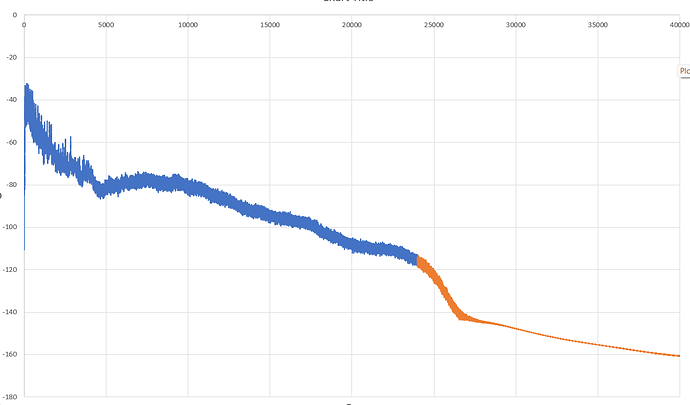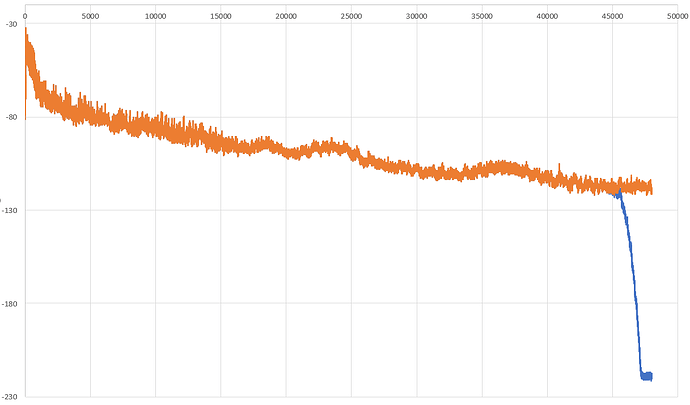It’s possible, although it seems to me it goes up to 27kHz or so before it really dies down. Here it is again, color-coded up to 24kHz; I would expect a more pronounced discontinuity there. I guess it depends on the decimation filter used in the ADC. In Roon, for example, you can select a DSD-to-PCM filter with a passband as low as 24kHz.
There are three performers in this track.
The piano was a midi capture. I used PianoTeq - which is a modelled rather than sampled piano. I think in this track I probably left it at its default 48k resolution.
The double bass and vocal were recorded via a Universal Audio Apollo X16 at 96/24
It was mixed “in the box” mostly using UAD and Fab Filter plugins. It wasn’t independently mastered - I just used a UAD compressor and FabFilter limited.
So the only DA conversion was in the X16
The video above really shows the recorded performances.
We tracked the bass first, added the piano (you can see it’s the same performer) and then recorded the vocal.
As someone who has spent a lot of time on this topic, and buys a fair amount of HRes music, I’d like to second @shankha 's opinions in this topic.
In fact, I’d encourage anyone to simply visit the website NativeDSD and look at any album on that site. There you will see detailed explanations of provenance, and can learn a fair amount about the recording and mastering process.
For example, you might have a new song that was originally recorded in DXD, then mastered in DXD, and then made available in DSD 512. Or you may have an older song that was remastered from the original analog tape and made available in DSD 128. Or you might have a new song that was recorded in DSD 256, then mastered in DXD, and then republished to DSD 256. Usually the mixing equipment is also noted in the “Additional Information” section.
If you don’t see provenance with the track/albumn, it’s likely a scam.
Sound Liaison is a great place to buy hi-res music (jazz mostly) - beautifully recorded and mastered.
I guesses you missed a few combinations ![]()
If anyone has a pricing scheme based solely on format (i.e. same album with different prices for red book, DXD, DSD64, DSD128 etc.), it’s surely a scam. I could buy the same album in two formats, look at the differences and show they’re well below audibility, but I don’t want to buy into this - literally.
I got some nice records from NativeDSD but alas, they would also happily sell you a DSD512 files of something that was originally recorded in DSD256. For more money of course.
I agree …a bit
Edit: I don’t at all
tib a… eeerga I! Ha
… that’s not bit perfect!
I just did a deep dive on tracks I bought from HDTracks and I was surprised. TBH I was skeptical that hi-rez tracks from albums recorded before the mid to late '70s could actually contain hi-rez information. Of all the tracks I looked at with sample rates higher than 44.1 kHz there was significant data above 20 kHz in the audio spectrum. Even files with high bit rates but 44.1 sample rates had data right up to 20 kHz and sometimes above. So it appears from my quick and dirty evaluation, HDTracks is indeed selling music mastered at higher than CD quality.
Was that PCM or DSD? Can you share the spectrum?
Sorry for the delay, I finally got to looking at this. This is the spectrum:
The orange graph is the original track. I can see ultrasonic content there. There are small humps around 23kHz (-90dB) and 36kHz (-100dB), not sure if those are because of the drums. What is interesting though is that there seem to be no significant filtering at the end of the range. The graph cuts abruptly at Nyquist frequency. Not a lot power there as the levels are around -120dB, but I guess there must have been some aliasing during decimation. I up-sampled the track to 192kHz and down-sampled back to 96kHz with Audacity and I got the blue graph. That shows significant attenuation before Nyquist frequency, which is what I’d like to see.
Interesting.
Since both missing and mastering were ‘in the box’ I’d guess this is from the AKM converters in the RME UFX+
BTW the track is one available for preview here if anyone is interested. You can listen a few times for free.
Ok, if it’s coming directly from the ADC, it makes sense. I captured 24/96 using my DA-3000 and I see a very similar curve. It cuts of around -120dBFS so not really a concern.

